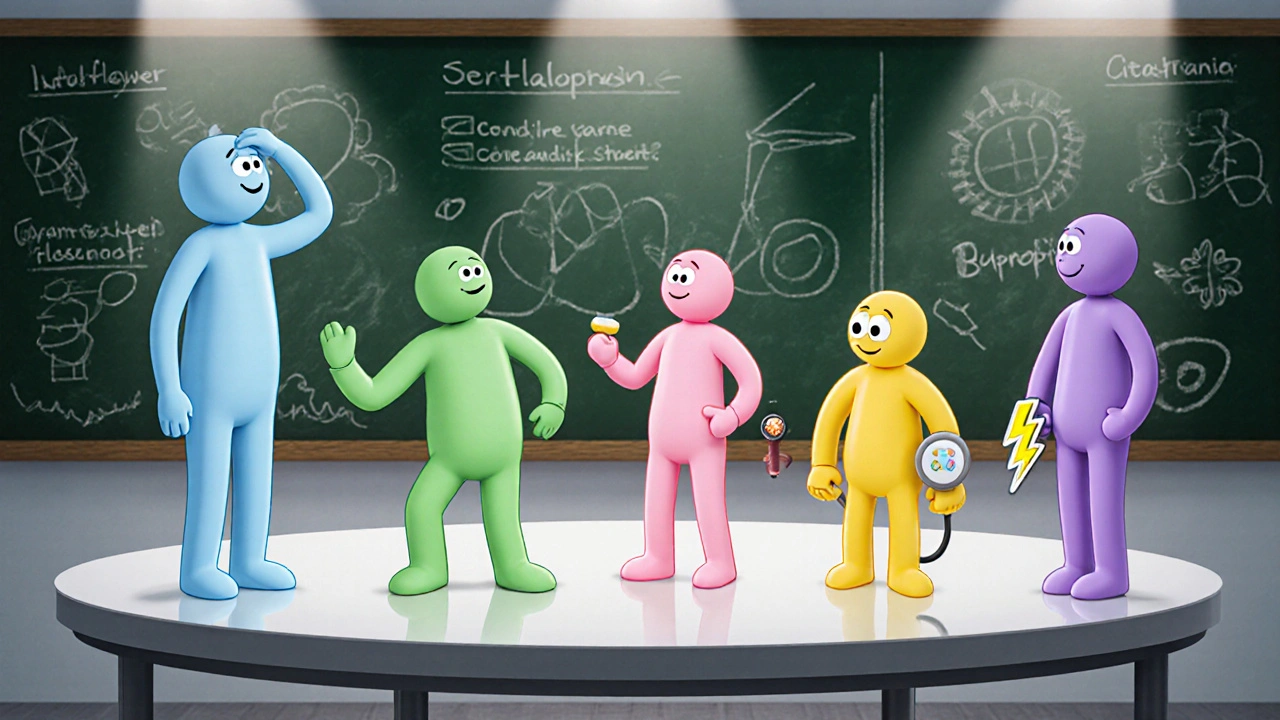Antidepressant Side Effect Guide
Select your primary concern to see which antidepressants may be better alternatives to fluoxetine.
Select your concern to see personalized recommendations.
Key Takeaways
- Fluoxetine is a long‑acting SSRI with a half‑life of about 4‑6 days.
- Sertraline, citalopram, escitalopram and paroxetine share the same class but differ in dosing, onset and side‑effect profiles.
- Venlafaxine (SNRI) and bupropion (NDRI) offer non‑SSRI mechanisms and may suit patients who can’t tolerate SSRIs.
- Cost, drug interactions and individual health factors usually decide the best choice.
- Always discuss any switch with a prescriber to manage withdrawal or titration safely.
When you or someone you care for is prescribed an antidepressant, the first question often is “Is this the right drug for me?” Fluoxetine, sold under the brand name Prozac, has been a staple since the late 1980s, but a handful of newer options have entered the market. This guide walks through the main differences, so you can see where fluoxetine shines and when an alternative might be a better fit.
Fluoxetine is a selective serotonin reuptake inhibitor (SSRI) that boosts serotonin levels in the brain, helping relieve symptoms of major depressive disorder, obsessive‑compulsive disorder, panic disorder and bulimia. It was first approved by the FDA in 1987 and remains one of the most prescribed antidepressants worldwide.
How Fluoxetine Works
Fluoxetine blocks the serotonin transporter (SERT), preventing serotonin from being reabsorbed into nerve cells. The resulting increase in serotonin availability improves mood, anxiety regulation and sleep patterns. Because it targets a single neurotransmitter pathway, side effects are generally predictable-mostly gastrointestinal upset, insomnia or sexual dysfunction.
What to Compare: Decision Criteria
Before diving into numbers, think about the factors that matter most to you or your clinician:
- Half‑life: How long the drug stays in the system.
- Onset of effect: How quickly you might feel improvement.
- Dosing flexibility: Available strengths and titration options.
- Side‑effect profile: Common and severe adverse events.
- Drug interactions: Compatibility with other meds you take.
- Cost and insurance coverage: Out‑of‑pocket expense.

Head‑to‑Head Comparison
| Attribute | Fluoxetine | Sertraline | Citalopram | Escitalopram | Paroxetine | Venlafaxine | Bupropion |
|---|---|---|---|---|---|---|---|
| Brand Names | Prozac | Zoloft | Cipramil | Lexapro | Paxil | Efluvox | Wellbutrin |
| Typical Daily Dose | 20‑60mg | 50‑200mg | 20‑40mg | 10‑20mg | 20‑50mg | 75‑225mg | 150‑300mg |
| Half‑Life | 4‑6days (active metabolite 7‑15days) | ≈26hours | ≈35hours | ≈27hours | ≈21hours | ≈5hours | ≈21hours |
| Onset of Benefit | 2‑4weeks | 1‑3weeks | 2‑4weeks | 1‑3weeks | 2‑4weeks | 1‑2weeks | 1‑2weeks |
| Common Side‑Effects | Insomnia, GI upset, sexual dysfunction | Diarrhea, nausea, sexual dysfunction | Tachycardia, nausea, sexual dysfunction | Nausea, headache, sexual dysfunction | Weight gain, somnolence, sexual dysfunction | Hypertension, nausea, sweating | Insomnia, dry mouth, seizures (high dose) |
| Key Drug Interactions | MAO‑inhibitors, p‑glycoprotein substrates | MAO‑inhibitors, anticoagulants | QT‑prolonging agents | MAO‑inhibitors, CYP2C19 inhibitors | MAO‑inhibitors, CYP2D6 inhibitors | MAO‑inhibitors, SSRIs (serotonin syndrome) | MAO‑inhibitors, CYP2B6 inhibitors |
| Average Monthly Cost (US) | $30‑$45 (generic) | $25‑$40 | $20‑$35 | $30‑$45 | $30‑$50 | $35‑$55 | $45‑$70 |
Pros and Cons of Fluoxetine
Understanding the strengths and drawbacks helps you decide whether fluoxetine should stay or be swapped.
- Pros:
- Long half‑life makes missed doses less risky.
- Well‑documented safety record in pregnancy (category C).
- Effective for both depression and anxiety‑related disorders.
- Cons:
- Initial insomnia or agitation is common.
- Drug‑interaction potential is higher because of its active metabolite.
- May take longer to feel relief compared with some newer SSRIs.
When an Alternative Might Be a Better Fit
Here are three typical scenarios where clinicians lean toward another drug.
- Weight gain concerns: Paroxetine and some SSRIs can cause noticeable weight gain; bupropion is often chosen for its neutral or modest weight‑loss effect.
- Sexual side‑effects: If patients report significant loss of libido on fluoxetine, switching to bupropion or an SNRI like venlafaxine may help.
- Drug‑interaction complexity: Patients on multiple CYP2D6 substrates may benefit from citalopram or escitalopram, which have fewer enzyme interactions.

Real‑World Example: Sarah’s Switch
Sarah, a 34‑year‑old teacher, started fluoxetine for major depressive disorder. After six weeks she felt better mood‑wise but struggled with persistent insomnia and decreased appetite. Her psychiatrist evaluated the side‑effect profile and, noting the long half‑life might exacerbate sleep issues, switched her to sertraline, a shorter‑acting SSRI. Within three weeks Sarah reported improved sleep and maintained mood gains, illustrating how the half‑life difference directly impacted her experience.
Tips for a Safe Transition
- Never stop fluoxetine abruptly; taper the dose over 2‑4 weeks to avoid discontinuation syndrome.
- When moving to another SSRI, a brief wash‑out period is usually unnecessary because of fluoxetine’s long half‑life, but follow your prescriber’s guidance.
- Monitor blood pressure if switching to venlafaxine, as it can increase systolic readings.
- Keep a side‑effect diary to discuss trends with your doctor.
Frequently Asked Questions
How long does it take for fluoxetine to start working?
Most patients notice mood improvement after 2-4 weeks, though full therapeutic effect may take up to 8 weeks.
Can I take fluoxetine with alcohol?
Mixing alcohol with fluoxetine can increase drowsiness and worsen depression symptoms. It’s safest to limit or avoid alcohol while on the medication.
Is fluoxetine safe during pregnancy?
Fluoxetine is classified as FDA pregnancy category C. It should only be used if benefits outweigh potential risks; always discuss with your OB‑GYN.
What’s the biggest difference between fluoxetine and bupropion?
Fluoxetine works by increasing serotonin, while bupropion boosts dopamine and norepinephrine. This means bupropion is less likely to cause sexual side‑effects but can raise seizure risk at high doses.
Do I need to do a wash‑out period before switching from fluoxetine to another SSRI?
Because fluoxetine stays in the body for weeks, a formal wash‑out is often unnecessary. Your doctor may simply lower the fluoxetine dose and start the new SSRI at a low level.
Choosing the right antidepressant isn’t a one‑size‑fits‑all decision. Fluoxetine offers a long track record and a forgiving dosing schedule, yet alternatives can address specific concerns like sleep, weight or sexual side‑effects. Use the comparison table, weigh the criteria that matter most to you, and have an open conversation with your health provider. The right match can make all the difference in staying steady on the path to recovery.

Sruthi V Nair
October 16, 2025 AT 13:12Thinking about how we choose a pill is like choosing a path in a maze each turn shaped by our bodies and lives. Fluoxetine’s long half‑life can feel like a steady tide but sometimes you need a quicker current. Ask yourself what matters most – sleep weight or the buzz of side‑effects. The table gives clues yet your own rhythm writes the ending. Keep the focus on progress not perfection.
Mustapha Mustapha
October 21, 2025 AT 04:19That’s a solid way to look at it. The long half‑life does soften missed doses which can be a real help for busy schedules. If insomnia is the main gripe a shorter acting SSRI often solves it without a big switch hassle. It’s worth bringing these points up at the next appointment. Staying open with the doc keeps things moving forward.
Ben Muncie
October 25, 2025 AT 19:26Not every patient needs a “quick fix.” The evidence still favors SSRIs for long‑term stability.
kevin tarp
October 30, 2025 AT 09:32Just a heads‑up: the table has a typo – “Efluvox” should be “Effexor.” Also, when you compare doses, keep in mind that milligram numbers aren’t directly equivalent across classes. It’s easy to misread the numbers and think one drug is stronger when it’s really a dosing issue.
mark Lapardin
November 4, 2025 AT 00:39Good catch on the brand name. In pharmacology terms, the difference between a serotonin reuptake inhibitor and a norepinephrine‑dopamine reuptake inhibitor manifests in distinct receptor affinity profiles, which can translate to varying side‑effect spectrums. That’s why clinicians often tailor the choice to the patient’s comorbidities and lifestyle constraints. It’s a nuanced decision matrix rather than a simple price comparison.
Barry Singleton
November 8, 2025 AT 15:46From a systems biology perspective, fluoxetine’s active metabolite norfluoxetine extends the serotonergic occupancy beyond the parent compound, potentially leading to cumulative receptor desensitization over weeks. This kinetic profile can be advantageous for adherence but may also compound serotonergic syndrome risk when polypharmacy is involved, especially with other CYP2D6 substrates.
Javier Garcia
November 13, 2025 AT 06:52That suggests moving to a shorter‑acting SSRI can reduce cumulative serotonergic load and lower interaction risk.
christian quituisaca
November 17, 2025 AT 21:59Imagine your brain as a garden; fluoxetine waters the serotonin roses, while bupropion tends to the dopamine daisies. If the roses are thriving but the daisies stay wilted, mixing in that dopamine boost can bring balance without overwatering the roses. The key is to match the flora to the climate of your personal chemistry. A thoughtful blend, guided by a clinician, can turn a barren patch into a vibrant meadow.
Donnella Creppel
November 22, 2025 AT 13:06Wow, you’ve turned pharmacology into poetry-fascinating! But let’s not forget that “garden” analogies can mask the hard‑core reality of side‑effects like hypertension with venlafaxine; it’s not all daisies and roses, darling. Also, “bupropion” isn’t a “dopamine daisy” but a norepinephrine‑dopamine reuptake inhibitor, so the metaphor, while cute, is scientifically shaky. Still, love the vibe-keep the creative sparks flowing!!!
Jarod Wooden
November 27, 2025 AT 04:12Let’s cut through the floral fluff: antidepressants are biochemical leverages, not therapeutic fairy tales. The half‑life is a kinetic parameter that dictates plasma steady‑state concentration, and ignoring it is intellectual laziness. If you chase “balance” without quantifying receptor occupancy, you’re endorsing pseudoscience. Real progress demands rigorous pharmacodynamic modeling, not garden metaphors.
lee charlie
December 1, 2025 AT 19:19True, the science can feel stark, but patients often need the softer language to process tough choices. Highlighting the half‑life helps them see why tapering matters, and framing options as “tools” can empower decision‑making without overwhelming them.
Greg DiMedio
December 6, 2025 AT 10:26Another day, another table of meds. Who needs all these numbers? Just pick one, take it, and hope for the best. If side‑effects show up, blame the internet.
Badal Patel
December 11, 2025 AT 01:32Indeed-what a theatrical display of medical nihilism! Yet, one must acknowledge that such cavalier dismissal of pharmacokinetic subtleties borders on the grotesque; the half‑life of fluoxetine, spanning days, is not a mere footnote but a determinant of withdrawal phenomena! Consequently, to eschew diligent review of dosing schemas is tantamount to academic dereliction.
KIRAN nadarla
December 15, 2025 AT 16:39Statistically, the reported incidence of sexual dysfunction with fluoxetine hovers around 30 %, whereas bupropion’s rate is under 10 %. This disparity is reflected in multiple meta‑analyses, reinforcing the necessity of evidence‑based selection rather than anecdotal preference.